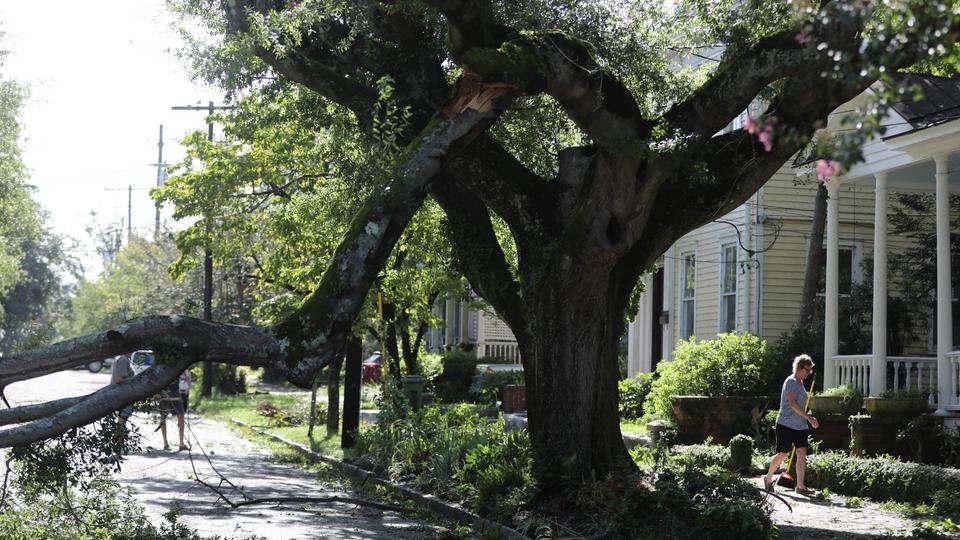
Isaias
Rsidents of Wilmington clean up tree branch debris after Hurricane Isaias made landfall near the town the night before in Wilmington, North Carolina on August 4, 2020. The Category 1 hurricane made landfall in the southern part of the state on Monday just before midnight, the National Hurricane Center said. Photo by LOGAN CYRUS/AFP via Getty Images.This story appears here courtesy of TheChurchNews.com. It is not for use by other media.
Updated August 5, 2020
By Jason Swensen, Church News
Latter-day Saints in eastern North Carolina don’t have to be told the second anniversary of the unforgettably destructive Hurricane Florence is fast approaching.
Hurricane Isaias was all the reminder they needed — reaching landfall late Monday night, August 3, and traveling north through the Tar Heel State, bringing with it flooding, strong winds and tornadoes.
The storm killed at least five people as it whipped up the East Coast on Tuesday, including several people whose deaths are being blamed on falling trees, CNN reported.
The center of the storm roughly followed the Interstate 95 corridor. All Latter-day Saint missionaries were safe and accounted for Tuesday.
“We moved them off the coast and had them sheltering indoors during the storm,” said Elder Matthew S. Harding, an Area Seventy and Raleigh resident, in a text to the Church News.
For Church members, the impact of the storm was felt strongest in the Wilmington North Carolina Stake.
“Lot of debris to clean up,” reported Elder Harding. “Our assessment efforts are still underway.”
A number of Latter-day Saints along Isaias’ path were dealing with power outages. The Wilmington, North Carolina, area had about 100,000 homes and businesses without power just before dawn Tuesday.
Internet and phone services were also limited in some areas.
“My only means of communication with the [Wilmington] stake president is through texting. He is doing well,” said Elder Harding.
Most of the initial damage, he added, appears to be wind-related. “All in all, it was a blessing that this storm was fast moving.”
About 2.6 inches fell at Raleigh-Durham International Airport since Monday evening, but the total topped 4 inches elsewhere in the county, according to the National Weather Service. Between 1 and 3.4 inches fell in Orange and Durham counties, according to The News & Observer.
An appropriate Latter-day Saint humanitarian response and volunteer cleanup needs were still being determined Tuesday.
It was almost two years ago Hurricane Florence inundated much of the Wilmington stake and other neighboring stakes. Many member families experienced significant flooding in their homes due to heavy rains and inundated waterways.
The disaster prompted a large-scale humanitarian response as members from across the region pulled on yellow Helping Hands vests and volunteered their time and muscle to the cleanup effort.
On Tuesday, Tropical Storm Isaias storm knocked out electrical power and inundated waterways in communities across the mid-Atlantic and Northeast.
As of Wednesday morning, August 5, power was out for nearly a million people in New Jersey, about 775,000 people in New York, and about 700,000 in Connecticut.
In all, outages stretched from North Carolina up to Maine, CNN reported. Meanwhile, high winds battered the U.S. East Coast. Peak wind gusts reached 67 mph in Greenwich, Connecticut; 68 mph at Newark Airport in New Jersey; and over 75 mph in multiple parts of New York’s Suffolk County.
In the Philadelphia neighborhood of Eastwick, Philadelphia, some residents were evacuated as streets transformed into rivers Tuesday. In the northeastern part of the city, roofs were torn off, wires were on the ground and residents told the news station they saw powerful winds ripping trees off the ground.
President Ray Barton, who presides over the Stafford Branch, East Brunswick New Jersey Stake, told the Church News, “the major issue was the wind … but we’ve fared fairly well.”
The branch is located a reasonably short drive from Atlantic City, Philadelphia and New York City.
President Barton spent much of his day Tuesday helping neighbors and fellow branch members clear up fallen tree branches and clear up debris. His primary concern was for the older members of his unit who are continuing to take precautions during the pandemic.
Gospel-anchored principles such as planning and ministering are proving invaluable in the aftermath of the storm, he added.
By Wednesday, August 5, the storm, now a post-tropical cyclone, had moved into southeastern Canada, bringing heavy rain and powerful winds over the province of Quebec.
Copyright 2020 Deseret News Publishing Company